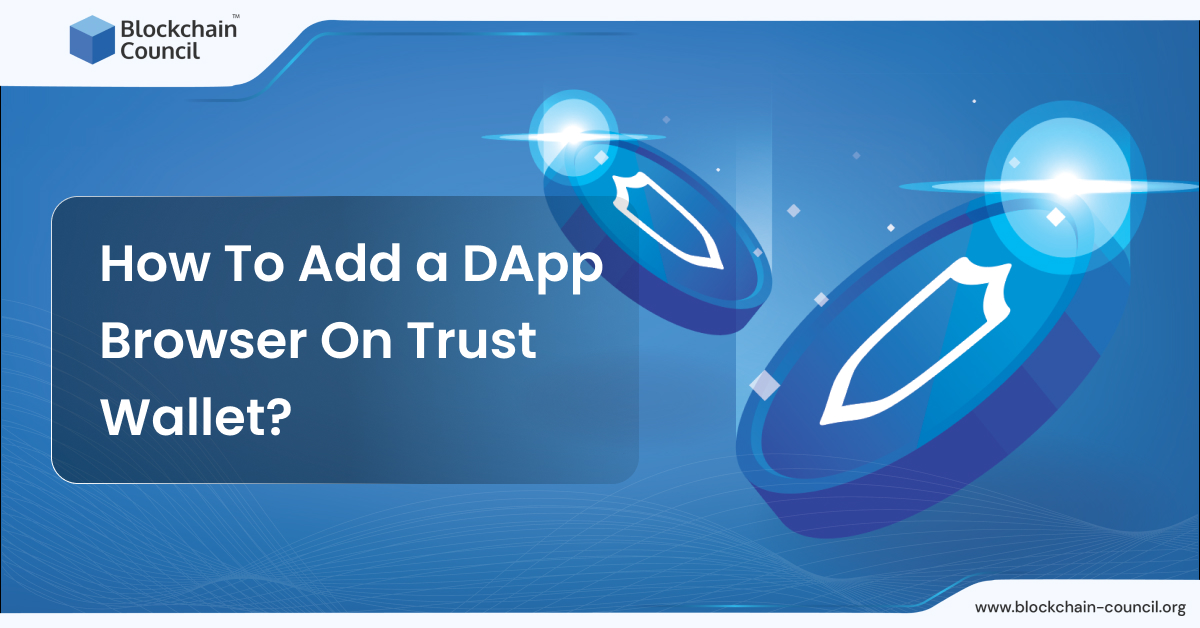
Menu
Menu
Home » Understanding Blockchain » How To Add a DApp Browser On Trust Wallet?

If you’re navigating the world of decentralized finance (DeFi) and cryptocurrencies, having a reliable DApp (Decentralized Application) browser is essential. Trust Wallet, a popular mobile wallet for managing digital assets, offers a seamless experience for users keen on exploring decentralized applications. In this article, we’ll guide you through the straightforward process of how to add a DApp browser to Trust Wallet. Whether you’re a seasoned crypto enthusiast or a newcomer to the space, this step-by-step guide will help you unlock the full potential of Trust Wallet’s capabilities.
A DApp browser, short for Decentralized Application browser, is a unique type of web browser designed specifically for interacting with decentralized applications (DApps) that operate on blockchain technology. Unlike conventional web browsers that connect users to centralized websites, DApp browsers facilitate access to a diverse array of applications functioning on a distributed network of computers.
In essence, these DApps leverage the decentralized nature of blockchain technology, which is a secure and transparent system where data is stored across a network of computers rather than on a single centralized server. This decentralized approach enhances security, transparency, and immutability in comparison to traditional, centralized systems.
One significant characteristic of DApp browsers is their compatibility with various domains of decentralized applications. These applications span a wide range of sectors, including decentralized finance (DeFi), online gaming, social media, and more. Each of these applications operates within the framework of a blockchain, ensuring a level of trust and security that is inherent to decentralized systems.
In practical terms, when a user interacts with a DApp through the specialized browser, they are engaging with a decentralized network of nodes that collectively validate and secure transactions. This stands in contrast to centralized applications, where a single entity typically manages and oversees the entire process. The decentralized approach not only enhances security but also eliminates the need for intermediaries, reducing the potential for censorship or manipulation.
Furthermore, DApp browsers often incorporate features that allow users to manage their blockchain-based assets, such as cryptocurrencies, seamlessly within the browser interface. This integration streamlines the user experience and fosters a more user-friendly environment for individuals navigating the decentralized landscape.
Also Read: Top 5 AI Prompt Generators – A Complete List
Trust Wallet is a cryptocurrency wallet that stands out for its focus on simplicity, security, and decentralized features. One unique aspect is its origin as an open-source project, initiated by Viktor Radchenko in 2017. It gained prominence for being one of the first mobile wallets designed exclusively for decentralized applications (DApps) on the Ethereum blockchain.
From a technical perspective, Trust Wallet is a non-custodial wallet, meaning it doesn’t hold onto users’ private keys or funds. Instead, it operates on the principle of client-side encryption, where the private keys are stored locally on the user’s device. This enhances security by reducing the exposure of sensitive information to potential online threats.
Moreover, Trust Wallet has evolved beyond its Ethereum-centric origins. It now supports a wide range of blockchain networks, including Binance Smart Chain, which enables users to interact with decentralized applications and store a diverse array of cryptocurrencies. The wallet’s ability to connect to multiple blockchains is made possible through the use of Hierarchical Deterministic (HD) wallet technology, allowing users to manage multiple crypto assets using a single seed phrase.
Trust Wallet also integrates with decentralized exchanges (DEXs), enabling users to trade cryptocurrencies directly within the app. This involves interacting with smart contracts on the respective blockchains, showcasing the wallet’s commitment to providing a decentralized and censorship-resistant trading experience.
In terms of user privacy, Trust Wallet employs techniques such as address book encryption and metadata obfuscation to enhance confidentiality. Additionally, it supports the use of privacy-focused cryptocurrencies and implements features like Tor network integration for enhanced anonymity during transactions.
Also Read: What are the Best AI Video Editing Tools?
Integrating a DApp browser into your Trust Wallet significantly expands your interaction with decentralized applications. This simple yet powerful feature allows you to explore the ever-growing world of DeFi, gaming, and other blockchain-based applications directly from the convenience of your mobile device. As the cryptocurrency landscape continues to evolve, having a user-friendly and secure platform like Trust Wallet, coupled with a functional DApp browser, empowers you to stay ahead and make the most out of the decentralized ecosystem.
What is Claude AI? Claude AI is a cutting-edge artificial intelligence chatbot developed by Anthropic, a company founded by former OpenAI employees with a strong
Since launching a startup has gotten much simpler these days than ever before, more and more young and ambitious students are trying themselves in business.
What is Undetectable AI? Defined Undetectable AI is a tool designed to detect AI-written text and make AI-generated content appear as if written by a
Solidity, the primary programming language for writing smart contracts on the Ethereum Blockchain, is becoming increasingly popular as the demand for decentralized applications grows. Here’s
Summary Poe AI, an innovative platform by Quora, allows users to create their own AI chatbots, offering unique opportunities for developers. Two bot creation frameworks
Crypto mining is a process that many people hear about but few understand fully. Let’s find out what crypto mining actually is! Cryptocurrency Mining Crypto
Summary Microsoft Copilot is an AI-powered assistant designed to boost productivity, creativity, and information management across Microsoft 365 and Windows. It replaces Cortana and operates
What Is AI Dungeon? AI Dungeon is a groundbreaking mobile gaming application that uses advanced artificial intelligence (AI) to generate limitless adventures. Unlike traditional games
Are you curious about a career in Power BI? With businesses relying more on data-driven decisions, the demand for Power BI professionals is rising. What
Power BI is a powerful business analytics service offered by Microsoft that enables you to visualize data and gain insights for better decision-making. While many
In our constantly changing digital world, cryptocurrencies have risen as a transformative power, altering how we view and exchange value. At the forefront of this
Web3 development is a growing field with many opportunities. As Blockchain technology and decentralized applications (dApps) become more popular, the demand for skilled Web3 developers
What is Janitor AI? Janitor AI is an innovative chatbot service that employs sophisticated artificial intelligence algorithms to facilitate natural and automated conversations between users
Valentine’s Day is around the corner, and it’s time to think about what to gift your loved one. Traditional Valentine’s gifts like chocolates, flowers, teddy
In the dynamic world of finance, trading stands as a cornerstone activity, offering individuals and institutions alike the opportunity to engage in the buying and
Summary Gemini and ChatGPT are two prominent AI technologies developed by Google and OpenAI, respectively, with distinct strengths and capabilities. Gemini, developed by Google DeepMind,
With the advancement of technologies, automation is also being introduced to various industries and forex is no exception to that. Automated programmes are now able
What is Blooket Hacks? Are you looking to maximize your Blooket experience with some clever tricks? Whether you’re a student aiming to boost your gameplay
Summary AI tools have become essential for data analysts, enabling the transformation of large datasets into actionable insights swiftly and accurately. These tools leverage advanced
The role of a Blockchain architect is vital in designing frameworks that drive innovation and efficiency in the decentralized digital world. As we advance into
Summary Content creation in the digital age is increasingly reliant on AI tools for efficiency and productivity. This step-by-step guide covers the use of various
Power BI Report Builder is an essential tool for creating paginated reports within the Microsoft Power BI ecosystem. It is designed for users who need
Graduating in 2024 opens up many paths for new graduates. With the job market constantly changing, it can be hard to know where to begin.
Blockchain Council presents its latest initiative, Project of the Month! Project of the Month is an initiative that recognizes and highlights outstanding projects and initiatives
Summary AI content detectors are crucial tools in today’s digital landscape, ensuring content remains authentic and original. They utilize sophisticated algorithms to distinguish between human-written
Bitcoin mining is a crucial process that ensures the security and functionality of the Bitcoin network. But what exactly is Bitcoin mining? Let’s find out!
In the past, business owners and leaders have mostly had to manually assess the risks their industries were exposed to. Arriving at this information would
Binary to Decimal Binary to decimal conversion means changing a number from the binary system (base-2) to the decimal system (base-10). In the binary system,
Summary Reinforcement Learning (RL) is a powerful form of machine learning where agents learn through trial and error to achieve goals, akin to learning to
Blockchain technology continues to evolve, and so does the demand for skilled developers. As we step into 2024, the landscape for Blockchain developers is rich
What is Blooket? Blooket is an innovative tool designed to make learning fun and engaging for students. It combines the excitement of gaming with educational
Summary Cryptocurrencies, despite facing challenges like volatility and regulatory scrutiny, are thriving due to their foundational qualities and technological innovations. Blockchain technology, the backbone of
Summary Novel AI is a groundbreaking AI-assisted tool revolutionizing storytelling and content creation in the rapidly evolving tech landscape. It caters to various creatives, from
Cryptocurrency and Blockchain technology have quickly become key players in the world of finance, offering a range of new opportunities and ways to conduct transactions.
What is Notion AI? Notion AI is an integrated feature within the Notion app, designed to enhance productivity and creativity for its users. This
How Much is Bitcoin Total Supply? Bitcoin has a maximum supply cap of 21 million coins. This limit is built into the Bitcoin protocol and
We have all heard of the place, right? At some point or other, this state has come to our notice, be it for its beauty,
Anytime you are a new entrant in a particular investing space or asset class, there are some things you should be doing to ensure you
Power BI Pro is a robust business analytics service provided by Microsoft. It enables users to visualize and share insights from their data through interactive
Summary Microsoft Copilot is a powerful AI tool designed to enhance productivity and creativity across various applications, making it essential for professionals in today’s AI-driven
Summary Programming skills are essential in today’s tech-driven world, with over half of digital career options requiring coding knowledge. Python, Node.js, and React are among
Summary When applying sentiment analysis, the major challenges are the limitations of mainstream NLP technologies when applied to a domain-specific problem and inaccurate assumptions about
Summary AI crypto trading bots leverage artificial intelligence to automate cryptocurrency trading, capitalizing on their ability to analyze data and execute trades 24/7 without emotional
What is Poe AI? POE stands for Platform for Open Exploration. It is a platform that allows users to ask questions, receive instant answers, and
We all are familiar with bitcoin, ETH Ethereum, ripple and other decentralized cryptocurrencies. Blockchain is the automated digital keeper that includes every business ever executed
A hard fork is a term you might come across often when reading about Blockchain technology. It plays a crucial role in how these systems
What is Perplexity AI? Perplexity AI is an innovative tool that elevates the way we find answers on the internet. It’s not just another
The year 2021 witnessed both the bearish and bullish crypto markets, but to sum up, it was a “lucky” one for the investors. The market
What Is the AI Platform Alaya AI? Alaya AI is a distributed AI data platform that helps in collecting, managing, and labeling data for AI
Becoming a Certified Bitcoin Professional is a straightforward process that can set you apart in the world of cryptocurrency. A certification shows you understand the
Công nghệ Blockchain đã nhận được nhiều sự chú ý trong những năm gần đây. Cách thức độc đáo của nó trong việc ghi chép
In the rapidly evolving landscape of artificial intelligence, one name that stands out for its innovation and creative potential is Leonardo AI. This platform has
Summary Women are leading significant advancements in Artificial Intelligence (AI), breaking barriers and shaping a more inclusive future in technology. Clara Shih, CEO of Salesforce
What is Bitcoin Cloud Mining? Bitcoin cloud mining is a popular way for people to earn bitcoins without investing a lot. It allows miners to
What is Copy.ai? Copy.ai is an advanced artificial intelligence (AI) writing assistant that harnesses the capabilities of machine learning and natural language processing algorithms to
Midjourney AI Midjourney AI is a generative artificial intelligence program developed by a San Francisco-based independent research lab. It specializes in creating images from textual
Crypto AI Trading Bots An AI crypto trading bot is a software program that uses artificial intelligence (AI) algorithms to analyze market data, execute trades,
What is Voicify AI? Voicify AI, also known as Jammable, is a digital platform that enables users to create music covers using artificial intelligence. It
What is Poe AI? Poe AI is known as the “Platform for Open Exploration.” It’s designed for seamless interaction with various AI chatbots, enabling users
The ERP software centralizes all business data, empowering businesses to fully control the inner processes and make informed choices for the future. In addition, all
Summary Otter.AI is a revolutionary voice-to-text transcription service that utilizes AI to convert spoken language into accurate, searchable text, enhancing productivity and collaboration. Founded in
What is the Value of 1 Bitcoin? As of June 11 2024, the value of 1 Bitcoin is approximately $ 68,384.73 USD. Bitcoin prices fluctuate
In today’s fast-paced digital world, technology has become an integral part of our lives, driving innovation, creating opportunities, and shaping the future. Whether you’re a
Summary AI chatbots are experiencing unprecedented growth, driven by the demand for enhanced customer service and operational efficiency in businesses. These chatbots leverage AI to
Summary Microsoft Azure is a comprehensive cloud computing platform offering over 200 products and services, empowering users to build, run, and manage applications across multiple
Today’s world is data-driven. Businesses rely heavily on analytics and insights to make informed decisions. DXC Technology, a global leader in IT services, offers comprehensive
What is Notion AI? Defined Notion AI is a writing assistant integrated into the Notion workspace that helps users write, brainstorm, edit, summarize, and more.
Power BI is a suite of business analytics tools designed to analyze data and share insights. To effectively use Power BI, it’s crucial to understand
Summary Leonardo AI is a leading platform in AI-driven art generation, offering a diverse range of pre-trained image models to cater to various artistic styles
Summary Traditional trading strategies struggle with the volatile and complex nature of the cryptocurrency market. AI offers a solution by analyzing data, predicting trends, and
The NovelAI Text Generator stands at the forefront of AI-assisted storytelling, providing a revolutionary platform for writers, creatives, and anyone interested in exploring the boundaries
What is Bing AI Image Creator? Bing AI Image Generator or Bing Image Generator is an innovative tool powered by an advanced version of OpenAI’s
What is Leonardo AI? Simplified Leonardo AI is a state-of-the-art platform for generating AI images. It turns your textual descriptions into unique, original digital
When it comes to grouping data in meaningful ways, clustering algorithms are invaluable tools. Two of the most popular methods used in data analysis are
Summary In the evolving digital landscape, ChatGPT, Blockchain, and Web3 intersect to redefine digital interaction, finance, and internet sovereignty. ChatGPT, developed by OpenAI, facilitates natural
What is Alaya AI? Alaya AI is an innovative platform that integrates AI and blockchain technology to manage and enhance AI data collection and utilization.
Power BI Gateway is a crucial component in the Microsoft Power BI ecosystem. As organizations increasingly rely on cloud-based analytics while retaining their data on-premises
What is Midjourney AI? Defined Midjourney AI is an advanced generative artificial intelligence tool that specializes in creating images from textual descriptions or prompts. It
Blockchain technology has gained a lot of attention in recent years. Its unique way of recording and verifying transactions offers a secure and transparent method
Java Developer Resume Are you a fresh graduate eager to start your career as a Java developer? Crafting a standout resume is your first step
Whats the Highest Paying Job in the World? Choosing the right career can make a significant difference in one’s life, especially when it comes to
Summary Artificial Intelligence(AI) is a branch of computer science that aims at building smart devices capable of accomplishing a wide variety of tasks that typically
Summary AI art generators leverage generative AI to transform text prompts into various styles of digital artwork, catering to both professionals and amateurs in the
Starting a new business can be incredibly challenging. Startups face limited resources and market information, so they need any information they can lean on to
Summary ChatGPT, created by OpenAI, is an AI chatbot known for generating responses that closely mimic human writing, significantly impacting the educational sector, including cryptocurrency
When was Bitcoin Actually Created? Bitcoin first appeared in 2008 when a paper describing it was published under the pseudonym Satoshi Nakamoto on October 31.
Web3 technology is changing the job market, offering new roles and opportunities for tech enthusiasts. With Blockchain, decentralized applications, and cryptocurrencies gaining traction, professionals with
What is Devin? Devin is introduced as the world’s first fully autonomous AI software engineer. Unlike previous AI models, Devin operates independently, handling entire
Summary Caktus AI is an AI-powered learning platform founded in 2022, aiming to transform education by assisting students and professionals in various tasks such as
If you own or work for a managed service provider, you may have noticed a surge in demand in certain industries because of the COVID-19
Ethereum remains a leading platform for decentralized applications (DApps) and smart contracts. As we look towards 2024, becoming an Ethereum developer offers immense opportunities. This
Summary AI image generators, like NovelAI, revolutionize digital creativity by translating text into stunning visuals, ushering in a new era of imaginative expression. NovelAI distinguishes
There has been a very noticeable shift in the public conversation surrounding cryptocurrencies over the last year. We have seen a marked increase in the
Summary AI Ethics can be defined as a set of guiding principles that various stakeholders use to ensure AI is developed and utilized in a
What is Novel AI? Novel AI refers to an advanced cloud-based artificial intelligence system designed for creating unique, human-like content. Based on user input, Novel
Summary GitHub Copilot is a transformative AI tool for coding, offering autocomplete-style suggestions, refactoring assistance, and more, to enhance developer productivity and efficiency. Setting up
Decentralized Finance (DeFi): Definition Decentralized finance (DeFi) technology is a new financial technology based on distributed ledgers similar to those used in cryptocurrencies. Banks and
Summary Find out the back story of the Tech token network project Why TCN chose Tron blockchain? Recent activities and upcoming plans on the great
Starting your career can be both exciting and challenging. One of the first steps is creating a resume that stands out. A key part of
Bing Image Creator Bing Image Creator or Bing AI Image Generator is an innovative tool launched by Bing. It incorporates cutting-edge AI technology to transform
What is the Current Bitcoin Market Cap? As of June 2024, the market capitalization of Bitcoin stands at approximately $1.359 trillion USD. This value represents
What is Alaya AI? Alaya AI Tool is an innovative platform that combines artificial intelligence (AI) with Blockchain technology to manage and improve the way
Mining Bitcoin is a way to earn this digital currency without directly buying it. Let’s understand what it is and how to mine Bitcoin? What
Summary Blockchain developers can leverage ChatGPT to enhance smart contract development, automating code generation and providing natural language explanations to streamline the process and reduce



Welcome to the Blockchain Council, a collective of forward-thinking Blockchain and Deep Tech enthusiasts dedicated to advancing research, development, and practical applications of Blockchain, AI, and Web3 technologies. Our mission is to foster a collaborative environment where experts from diverse disciplines share their knowledge and promote varied use cases for a technologically advanced world.
Blockchain Council is a private de-facto organization of experts and enthusiasts championing advancements in Blockchain, AI, and Web3 Technologies. To enhance our community’s learning, we conduct frequent webinars, training sessions, seminars, and events and offer certification programs.
To receive Offers & Newsletters
50,000+ Professionals Certified so far by Blockchain Council

Coupon
expires in
Enroll today in any of the popular certifications curated as per the Industry trends.
